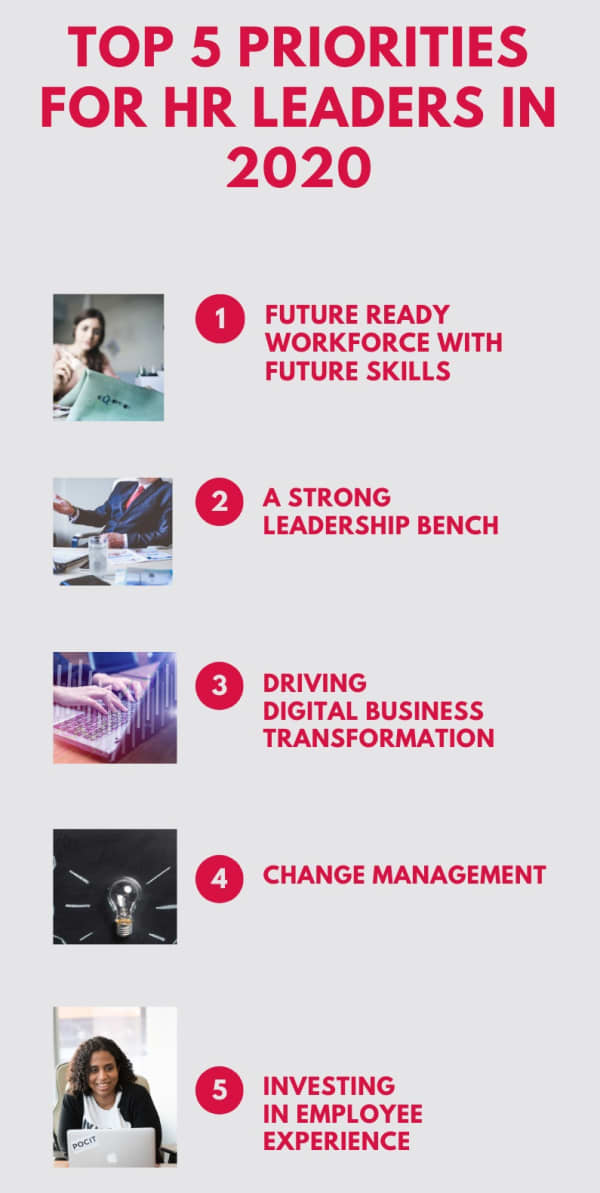What are top 5 priorities for HR leaders for the future of work

A Gartner research claims that only 9 percent of CHROs believe that their organization is prepared for the future of work. Keeping this in mind, as 2020 approaches, it becomes even more critical for HR leaders to focus on key drivers to be ready for uncertain times. While digitalization is rapidly revamping the business landscape but what is missing is the preparedness as far as key skills are concerned.
Leah Johnson, Vice-president of advisory in the Gartner HR practice seconds this and states, “HR leaders’ priorities for 2020 reflect the critical needs that organizations need to tackle in order to successfully operate in today’s uncertain conditions. While digital transformation has already generated skill gaps and strained leadership capabilities, we are also seeing that companies are missing the skills needed to restructure their businesses and manage the change that every organization is facing.”
What are those 5 top priorities that should be on the list of every CHRO for 2020 and the future of work? As per the research report Gartner Top Priorities for HR Leaders in 2020, here’s what they are-
A future-ready workforce with future skills
Automation and digitalization are rapidly changing the skills and competencies required for success and organizations are having trouble keeping up. As per a recent Gartner survey, 46% of HR leaders report that their employees lack the skills that are necessary to drive future performance.
Thus to make sure employees have the requisite skills, HR leaders need to work with business leaders to understand what should be the proper balance of emerging, existing and legacy skill sets. The HR team will also need to work with managers in order to help employees understand how they will grow personally by developing the most in-demand skills. Also, they need to make sure such skill-building opportunities are available to employees beyond their existing roles.
A strong leadership bench
Just as employees need to upskill for the future, similarly leaders also need to reinvent themselves to take on their expanded responsibilities and fulfill heightened expectations from them. As per the report, 45% of HR leaders struggle to develop effective midlevel leaders and more than one-third struggle to develop effective senior leaders.
In order to build a strong leadership front, HR should experiment with a “complementary leadership” model that partners leaders together to share responsibilities based on complementary skill sets. These leader partnerships will enable each leader to specialize in core skills, develop needed skills and lead in critical areas. Gartner's analysis reveals that leaders who use complementary leadership saw a 60% increase in their teams’ performance.

Change Management
In uncertain times, it even becomes more important for HR leaders to ensure that the work environment is such that it makes work easier. Gartner's research shows that 57% of employees face significant barriers in their day-to-day work. Some of these barriers are because of the amount of change in today’s environment — the average employee experienced 12 organizational changes in 2019, which ranged from major transformations like restructuring or executive leadership transitions to more day-to-day but still disruptive changes such as moving to a new team.
In order to counter the effect of these changes, HR leaders need to involve the right employees as active participants in making and shaping change decisions. This, in turn, cuts down the risk that employees will become fatigued by 50%, compared to a traditional top-down approach.
Driving digital business transformation
While the focus in 2020 for almost all nearly all businesses is digitalization, 43% of HR leaders reported that their organization does not have a clear and consistent strategy for it. In addition, organizations are also struggling on the talent front. 35% of HR leaders say they have inadequate talent to drive this transformation.
In order to make real progress in this direction, HR needs to take a lead on digital transformation by doing the following:
• Become experts in digital business: Collaborate with leaders to address digital goals and ensure they are consistent with the organization’s strategy.
• Leverage talent processes: Track employees’ skills to develop and refine the organization’s digital plans and prevent execution blind spots.
• Deliver functional support: Motivate HR teams to make meaningful contributions to digital business transformation and actively review HR strategies to stay consistent with the changing needs and expectations of employees and business leaders.
Investing in Employee Experience
It is no more a mystery that enhancing the employee experience is a key talent concern for HR leaders in 2020. While organizations are investing significant resources, yet 46% of employees remain largely dissatisfied, as per a recent Gartner survey.
To increase employee experience satisfaction, organizations need to focus more on how employees feel. They need to manage the memory of the overall employee experience by jogging the employees’ memories of positive experiences and reframing their memories of negative experiences. Gartner's research reveals that by incorporating a shaping approach in their employee experience strategy, organizations can improve employee satisfaction with their experience by more than 30%, thus boosting not only employee retention but also employee performance.
















